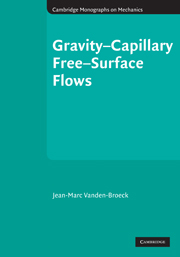Book contents
- Frontmatter
- Contents
- Preface
- 1 Introduction
- 2 Basic concepts
- 3 Free-surface flows that intersect walls
- 4 Linear free-surface flows generated by moving disturbances
- 5 Nonlinear waves – asymptotic solutions
- 6 Numerical computations of nonlinear water waves
- 7 Nonlinear free-surface flows generated by moving disturbances
- 8 Free-surface flows with waves and intersections with rigid walls
- 9 Waves with constant vorticity
- 10 Three-dimensional free-surface flows
- 11 Time-dependent free-surface flows
- References
- Index
7 - Nonlinear free-surface flows generated by moving disturbances
Published online by Cambridge University Press: 07 September 2010
- Frontmatter
- Contents
- Preface
- 1 Introduction
- 2 Basic concepts
- 3 Free-surface flows that intersect walls
- 4 Linear free-surface flows generated by moving disturbances
- 5 Nonlinear waves – asymptotic solutions
- 6 Numerical computations of nonlinear water waves
- 7 Nonlinear free-surface flows generated by moving disturbances
- 8 Free-surface flows with waves and intersections with rigid walls
- 9 Waves with constant vorticity
- 10 Three-dimensional free-surface flows
- 11 Time-dependent free-surface flows
- References
- Index
Summary
We now return to the free-surface flow generated by a moving disturbance and extend the results of Chapter 4 to the nonlinear regime. We shall see that the wave trains in the far field (if they exist) are then described by the nonlinear theories of Chapters 5 and 6. Furthermore we will show that the nonuniformities of Figures 4.9 and 4.8 are removed when a nonlinear theory is used. Some nonlinear solutions described in this chapter approach the linear solutions of Chapter 4 as the size of the disturbance approaches zero, while others approach solitary waves.
We have organised the results in the following way. In Section 7.1 we present pure gravity free-surface flows (i.e. g ≠ 0, T = 0) in water of finite depth and show in Section 7.1.1 that the nonuniformity of the linear supercritical solutions near F = 1 (see Figure 4.9) is removed when a nonlinear theory is used. Subcritical flows are considered in Section 7.1.2. In Section 7.2 we consider gravity–capillary free-surface flows. Solutions in water of finite depth are described in Section 7.2.1. We show in Section 7.2.2 that the nonuniformity of the linear theory near α = 0.25 (see Figure 4.8) is removed when a nonlinear theory is used. We examine in Section 7.3 the implications of the existence of multiple branches of periodic gravity–capillary waves (see Sections 5.1.2 and 6.5.3) for free-surface flows generated by moving disturbances in water of infinite depth.
- Type
- Chapter
- Information
- Gravity–Capillary Free-Surface Flows , pp. 191 - 209Publisher: Cambridge University PressPrint publication year: 2010



